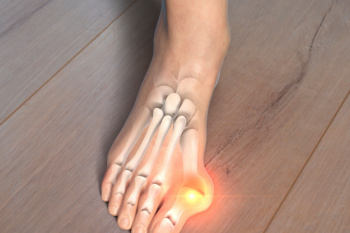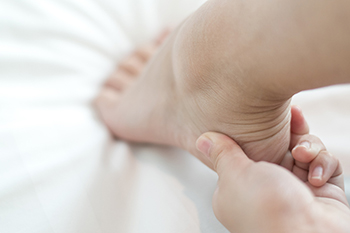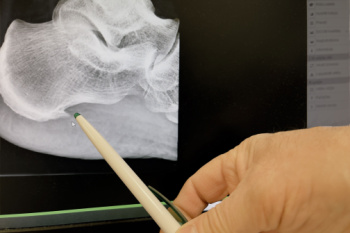
A bunion, also known as hallux valgus, is a bony bump that forms at the base of the big toe. It occurs when the big toe moves toward the second toe, causing the joint to protrude and become misaligned. This misalignment can lead to pain, swelling, and redness around the affected area, making it difficult to wear certain shoes. Bunion formation is often gradual, and the condition can worsen over time without treatment. There are several risk factors that increase the likelihood of developing a bunion, including a family history of the condition, wearing tight or ill-fitting shoes, and certain foot deformities. Additionally, women are more prone to bunions than men, likely due to the frequent wearing of high heels. Bunions can also develop as a result of arthritis or other medical conditions that affect the joints. If left untreated, bunions can cause difficulty walking and further joint damage.If you have any of the above symptoms, it is suggested that you consult a podiatrist who can accurately diagnose and offer effective treatment solutions for bunions.
If you are suffering from bunions, contact one of our podiatrists of Mercer Ocean Podiatry. Our doctor can provide the care you need to keep you pain-free and on your feet.
What Is a Bunion?
A bunion is formed of swollen tissue or an enlargement of boney growth, usually located at the base joint of the toe that connects to the foot. The swelling occurs due to the bones in the big toe shifting inward, which impacts the other toes of the foot. This causes the area around the base of the big toe to become inflamed and painful.
Why Do Bunions Form?
Genetics – Susceptibility to bunions are often hereditary
Stress on the feet – Poorly fitted and uncomfortable footwear that places stress on feet, such as heels, can worsen existing bunions
How Are Bunions Diagnosed?
Doctors often perform two tests – blood tests and x-rays – when trying to diagnose bunions, especially in the early stages of development. Blood tests help determine if the foot pain is being caused by something else, such as arthritis, while x-rays provide a clear picture of your bone structure to your doctor.
How Are Bunions Treated?
- Refrain from wearing heels or similar shoes that cause discomfort
- Select wider shoes that can provide more comfort and reduce pain
- Anti-inflammatory and pain management drugs
- Orthotics or foot inserts
- Surgery
If you have any questions, please feel free to contact our office located in Toms River, NJ . We offer the newest diagnostic and treatment technologies for all your foot care needs.

Children's foot and heel pain can result from various causes, including growth-related issues, injuries, and underlying conditions. One common condition is calcaneal apophysitis, often referred to as Sever's disease. This condition develops when the growth plate in the heel becomes inflamed due to overuse or excessive pressure. Children who are active in sports, especially running or jumping activities, are at higher risk. The anatomy of the foot and heel includes several important structures, including bones, muscles, ligaments, and tendons. The heel bone, or calcaneus, plays a key role in weight-bearing and walking, while the growth plates allow for bone lengthening as children grow. Pain in the heel or foot can result from irritation or stress on these structures. Wearing proper footwear, rest, and stretching exercises are essential for relieving discomfort and supporting healthy foot development. If your child has heel pain, it is suggested that you consult a podiatrist who can determine what the cause is, and offer viable treatment solutions.
Many people suffer from bouts of heel pain. For more information, contact one of our podiatrists of Mercer Ocean Podiatry. Our doctor can provide the care you need to keep you pain-free and on your feet.
Causes of Heel Pain
Heel pain is often associated with plantar fasciitis. The plantar fascia is a band of tissues that extends along the bottom of the foot. A rip or tear in this ligament can cause inflammation of the tissue.
Achilles tendonitis is another cause of heel pain. Inflammation of the Achilles tendon will cause pain from fractures and muscle tearing. Lack of flexibility is also another symptom.
Heel spurs are another cause of pain. When the tissues of the plantar fascia undergo a great deal of stress, it can lead to ligament separation from the heel bone, causing heel spurs.
Why Might Heel Pain Occur?
- Wearing ill-fitting shoes
- Wearing non-supportive shoes
- Weight change
- Excessive running
Treatments
Heel pain should be treated as soon as possible for immediate results. Keeping your feet in a stress-free environment will help. If you suffer from Achilles tendonitis or plantar fasciitis, applying ice will reduce the swelling. Stretching before an exercise like running will help the muscles. Using all these tips will help make heel pain a condition of the past.
If you have any questions please contact our office located in Toms River, NJ . We offer the newest diagnostic and treatment technologies for all your foot and ankle needs.

A heel spur is a bony growth that forms on the underside of the heel bone, often as a result of prolonged strain and pressure on the foot. This condition is commonly associated with plantar fasciitis, an inflammation of the tissue along the bottom of the foot. The main symptom of a heel spur is sharp pain at the bottom of the heel, particularly when standing up after a period of rest, such as first thing in the morning. The pain can also worsen after prolonged periods of standing or walking. Risk factors for developing heel spurs include being overweight, having flat feet or high arches, and wearing improper footwear. Also, engaging in activities that put excessive strain on the feet, such as running or standing for long periods of time may lead to developing a heel spur. Age and certain medical conditions, like diabetes, can increase the likelihood of developing heel spurs as well. If you have heel pain, it is suggested that you consult a podiatrist who can provide an accurate diagnosis and treatment.
Heel spurs can be incredibly painful and sometimes may make you unable to participate in physical activities. To get medical care for your heel spurs, contact one of our podiatrists from Mercer Ocean Podiatry. Our doctor will do everything possible to treat your condition.
Heels Spurs
Heel spurs are formed by calcium deposits on the back of the foot where the heel is. This can also be caused by small fragments of bone breaking off one section of the foot, attaching onto the back of the foot. Heel spurs can also be bone growth on the back of the foot and may grow in the direction of the arch of the foot.
Older individuals usually suffer from heel spurs and pain sometimes intensifies with age. One of the main condition's spurs are related to is plantar fasciitis.
Pain
The pain associated with spurs is often because of weight placed on the feet. When someone is walking, their entire weight is concentrated on the feet. Bone spurs then have the tendency to affect other bones and tissues around the foot. As the pain continues, the feet will become tender and sensitive over time.
Treatments
There are many ways to treat heel spurs. If one is suffering from heel spurs in conjunction with pain, there are several methods for healing. Medication, surgery, and herbal care are some options.
If you have any questions feel free to contact our office located in Toms River, NJ . We offer the latest in diagnostic and treatment technology to meet your needs.

Treat your feet with the care they deserve to keep them healthy and strong. Routine foot maintenance is key. Wash and moisturize feet daily, trim nails carefully, and check for any signs of trouble like redness, swelling, or pain. Stretching is equally important. Simple exercises like toe stretches, ankle rolls, and calf stretches improve flexibility, boost circulation, and reduce tension. Wearing proper shoes makes all the difference. Choose supportive, well-fitted footwear with ample cushioning to protect your feet from strain and injury. Avoid overly tight or worn-out shoes that can lead to blisters, bunions, or more serious problems. For expert guidance, regular visits to a podiatrist are suggested. This type of doctor can assess your foot health, provide personalized advice, and treat any foot injuries or conditions.
Everyday foot care is very important to prevent infection and other foot ailments. If you need your feet checked, contact one of our podiatrists from Mercer Ocean Podiatry. Our doctor can provide the care you need to keep you pain-free and on your feet.
Everyday Foot Care
Often, people take care of their bodies, face and hair more so than they do for their feet. But the feet are a very important aspect of our bodies, and one that we should pay more attention to. Without our feet, we would not be able to perform most daily tasks.
It is best to check your feet regularly to make sure there are no new bruises or cuts that you may not have noticed before. For dry feet, moisturizer can easily be a remedy and can be applied as often as necessary to the affected areas. Wearing shoes that fit well can also help you maintain good foot health, as well as making it easier to walk and do daily activities without the stress or pain of ill-fitting shoes, high heels, or even flip flops. Wearing clean socks with closed shoes is important to ensure that sweat and bacteria do not accumulate within the shoe. Clean socks help to prevent Athlete’s foot, fungi problems, bad odors, and can absorb sweat.
If you have any questions please feel free to contact our office located in Toms River, NJ . We offer the newest diagnostic and treatment technologies for all your foot and ankle needs.
